Menus
- The handyman
- Discovery
- In the saddle
- Contact
- City
- Highway
- Departmental
- Comfort
- Braking
- Convenient
- Consumption
- On occasion
- Conclusion
- User perspective
- Laurent
- Marion
The handyman
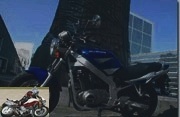 The
The
Suzuki GS 500 is the queen of motorcycle schools: a twin-cylinder of 500
puncture-proof cc at a minimum price, launched in 1989, and delivered
up to date in 2001. At the end of this makeover, the GS 500
gained a new back line, "borrowed"
to the GSX1400, a thicker saddle, a tank
larger than three liters, and a flat handlebar to replace the
half-handlebars. Older than the ER-5 and CB500, it just won
a new youth.
Discovery
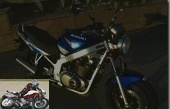 the
the
the key word of the GS 500 is discretion. In a livery
blue, we especially notice its huge angular tank,
and a saddle that appears large and soft. This is what we call
a basic one. Despite this, she lacks nothing and even understands
a central stand and a passenger handle. What to ask
what’s more ?
In the saddle
 The
The
motorbike is small. Sitting, the saddle is low and the feet touch easily
earth, even for small riders. In fact, it is the large reservoir
which tends to spread the thighs and for short legs
eventually prevent them from touching flat.
 the
the
handlebars fall well to hand and position natural. Under the eyes,
a counter and a traditional tachometer, under which are
the neutral, oil, turn signal and full headlight warning lights.
Round mirrors are easily adjusted and provide
a wide field of vision.
Contact
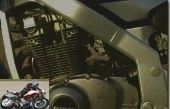 the
the
twin-cylinder starts slowly, without even requiring
the starter. The sound is discreet.
Clutch, start … You can feel the torque of the twin cylinder, limit
brutal on the first reports, especially as one easily reaches
the 6,000 laps in second and third. The first reports
reserve their share of surprises with a vigor that one imagines
little on a small displacement. Everything is light and easy to handle
like a bicycle. The knees tighten the tank well all
being further apart than on other basics or
same roadsters. We just regret a slightly dry box.
City
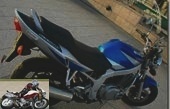 that
that
sneaks everywhere! The GS is an example of liveliness and maneuverability,
even if it is much less playful than an SV for example.
And as long as we stay in four or five, at 4,000 turns
at 60 km / h, one has the impression of driving on velor; engine
is totally forgotten. Want to play a little, in second and third,
it climbs briskly up to 9,000-10,000 rpm, while
that the cavalry arrives from 7,000 rpm.
Highway
The desire to see how the bi tent is doing, like a challenge.
He is very comfortable there, even if
the absence of fairing will reduce the ardor to the first 140
km / h. At only 7,000 rpm and far from the red zone at 11,000
rpm, it still keeps the reserve at this rate
and well launched will be able to titillate the 185 km / h, more than enough
lose his license. There are only 50 horses, but they are very
volunteers.
Departmental
The return to departmental is done in continuity.
In fact, the GS 500 accepts everything the same way.
Comfort
 Yes
Yes
the saddle offers a semblance of comfort, the shock absorber does not help and
the whole is particularly dry. The road connections are good
felt. It is perhaps rudeness to be blamed
a new shock absorber: the motorcycle barely displays 2,000
km.
Braking
 Despite
Despite
a simple disc at the front and rear, here
brakes. We can’t pretend to ask for an extraordinary feeling,
but it is effective. We can even take the brakes in an emergency,
and that does not block, allowing despite everything to stop
over a particularly short distance: tested under conditions
with a truck that pounded me a few meters on
the ringroad.
Convenient
 In
In
general, there is room for an anti-theft device. It is undoubtedly necessary
find the right one, because there is a slim possibility of placing one
a. But none of the ones I usually use passed. Stowed
at the engine level, this allowed the rubber protection to melt
du U: therefore to be avoided.
The passenger handle is central. She leaves room for
hang on well.
The large metal tank allows for a large
magnetic satchel, well flat and reveals itself
convenient.
Hooks under the saddle allow you to hang things.
Consumption
With 5.5 liters per hundred, it’s clearly a bird’s appetite.
Associated with the capacity of the tank, the autonomy
quietly exceeds 300 km.
On occasion
 Reliable,
Reliable,
the GS 500 can provide good and loyal service beyond 50,000
km. Basic, it will not have suffered thrill seekers,
wheeling, stopped starts and burns. On the other hand, in
as long as a motorbike school she may have suffered: falls may have
leaving a crooked frame, the slow ride overheats the engine, and
prematurely wear out the distribution. She also asks
a minimum of maintenance which small budgets do not always have:
the result may be corrosion at all levels.
So be careful when buying.
Conclusion
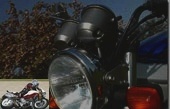 The
The
GS 500 is pleasant to use, tireless,
unsurprisingly, but with a couple making it possible to have a picnic
some four cylinders in town; she keeps enough to give
good impressions to its owner.
Its allure dessert, because its heart promises a lot and the desire for a
larger displacement will undoubtedly pass the biker to
a new model without having really exploited
the GS 500 to its limits. Formerly below 30,000
francs in nine (today 4,800 euros), she does not fear the first
falls and is very economical in maintenance.
The icing on the cake, it is not part of the list of motorcycles frequently
stolen. In short, it’s an excellent bike for beginners who
will nevertheless provide its share of sensations.
Strong points
- price / quality ratio
- the vigor of the twin cylinder
- reliability
Weak points
- look
- comfort
User perspective
Laurent
"It’s hard to be a student and passionate about
motorbike (finances !!!) But the GSE is ultimately a good compromise that allows
to get your hands on with a little confidence! In addition to
nearly 73,000 terminals now: not the slightest glitch !
I touch wood!".
Marion
"For a first bike, the GSE is nice especially for a
girl … but I was surprised by her important drink
of oil which brought me some setbacks. That said, I want
to switch after almost a year of license to a somewhat
more powerful and nervous. "
Competitors: Honda CB 500, Kawasaki ER6, Kawasaki
GPZ 500, Yamaha Diversion 600
Datasheet
Related articles
-
There is the motorcycle and then there is the scooter for purely urban use. We are looking for the small inexpensive machine, practical with all the same…
-
The mid-size trail passes Euro 4 standards: 645 cm3, 71 hp and 62 Nm, 216 kilos, € 8,899 A simple, accessible, versatile and efficient motorcycle For 7…
-
Triumph Legend 900 motorcycle test
Biker test: Evelyne I got married with a biker at the age 40 years old. Wishing to share the passion of my companion, I pass my motorcycle license at the…
-
Single cylinder, 4-stroke, 124 cc, 15 hp, 133 kilos, from € 4,099 A stylish and sporty little roadster for young people or beginners The roadsters being…
-
Honda CBF 1000 ABS motorcycle test
The Honda CBF 1000 is the big sister of the CBF 600, which appeared in 2006. Apart from a slightly larger size, the two models are aesthetically very…
-
Honda Varadero 1000 XLV motorcycle test
Maxi-Trail with a road vocation The Honda XL 1000 V Varadero, which appeared in 1998, is the heir to the famous Africa Twin … but the manufacturer has…
-
Honda CMX 500 Rebel S motorcycle test
Little rebellious bobber In-line twin, 471 cm3, 45 hp at 8,500 rpm, 44.6 Nm at 6,000 rpm, 190 kilos, € 6,299 Rather bi or 4? It’s that the couple is…
-
BMW GS 1250 motorcycle test daily
Flat Twin ShiftCam of 1,254 cm3, 136 hp and 143 Nm, 249 kg full made, from 17,599 euros Daily test for 15 days Already more than 800,000 big GS sold in…
-
Roadster with Sugomi sauce or decarenated sports car A2 licenses have the choice between large bridles, sometimes very badly bridled, and smaller ones,…
-
Triumph Daytona 600 motorcycle test
The wild stallion With the commercial failure of his 600 TT (and yet it was an excellent GT-Sport cf. test) and its first sporty 4-cylinder, Triumph has…
The, okay, why have it stashed, well, certainly the protection in front of the setting protects the passenger from the pangs of dirt in the event of rain.
Honestly, I have Norge suitcases on my Breva, never had any problem removing the said suitcases, I find the system rather simple, and the little "trick" to note before removing them is a safety if Didn’t you see that, for example, the suitcase was not locked, you don’t have to put it on; simple, effective in addition.
Obviously, the one who descends from a 1000 RRR …. but having seen some pilot it, well, it is doing well. Of course solo, two, we are not there to attack excessively.
The sound is more evolved than on some competitor…
Let’s admit, yes, after 800 kms, it can be useful.
If we could all grow old like this and then that’s what makes its charm.
and then that’s what makes its charm. And its "reasonable" price.
And its "reasonable" price.
Well! My gse 500 my first bike, I did 150km to go see the enduro, sore ass but so good for two! Well, it’s not with this bike that we pack the chicks but! Since I already have my young lady, I can tell you! it gives him sensations xD In short! Perfect ! Except the oil consumption to monitor regularly … Mine at barely 20,000 km, it had many crashes with the former owner and I can tell you, it is fine
I have nothing against comparisons, but I think we have to put things in perspective. An inaccessible shock absorber adjustment (of origin) can seem quite a defect for the potential owner in the process of inquiring, especially when one evokes the presence of electronic adjustment in the competition. Add to the criticism the observation that this is not something that is necessarily used very often (and that the dial is actually perfectly accessible if you remove the left suitcase and crouch down next to the silencer), and everything fits in the context.
It’s the same for the suitcases, their handling could be simpler (still I do not see badly how), but at least show that the duration of the tests did not make it possible to become familiar with the small whims of the system! (For analogy, I do not think I have read remarks on the ignition key of certain Honda … and yet I had to take a hand to insert it so that I could turn the ignition properly, unlike the situation on the Guzzi news). The real weak points of these cases are other: tightness, their internal shape which is difficult to use effectively, and if you want the ergonomics of the wrist.
Besides, I more soie Bernie: the small side covers are really effective, also against the cold (checked on hundreds of terminals with a partially broken cover).
It is also the same for equipment such as a radio, cruise control etc. Rather of letting their absence show up as a negative point, why not just say it’s in line with the old-fashioned design? And that these are options that are not difficult to add from OEMs and music player manufacturers (which also gives a much better sound quality, and avoids disturbing everyone!)
In short, I had seen that the conclusion is positive on the whole, but I find that you quibble on these few negative points – especially when you see the difference in price (and the pleasure obtained O with competition GTs!
with competition GTs!
Which less road-going machines have better protection ???
Quite a few big trails, especially the Versys, Tiger 1200, Crosstourer. As an equivalent, maybe even the Stelvio … and streamlined roadsters …
I had a Norge 2V for two years and I have a hard time finding myself in this test. We reproach the norge for its lack of electronics when it is a big advantage if we want to avoid trouble. I had an ESA equipped r1200RT: the system is far from perfect for settings, ages poorly and has broken down three times. so much the better if the Norge does not have one. The car radio neither moreover and in my eyes, it borders on total delirium by blaming that on a motorcycle on which this kind of equipment has no place.
The suitcases of norge and their fixing: very safe and very practical fixing, contrary to what is said; we adapt very quickly.
The Norge succeeded in my case to an R1200RT precisely and I loved the Norge, its character, its simplicity, its reliability (unlike the behem), its very great comfort, different perhaps from that of a RT but also good finally.
Franck